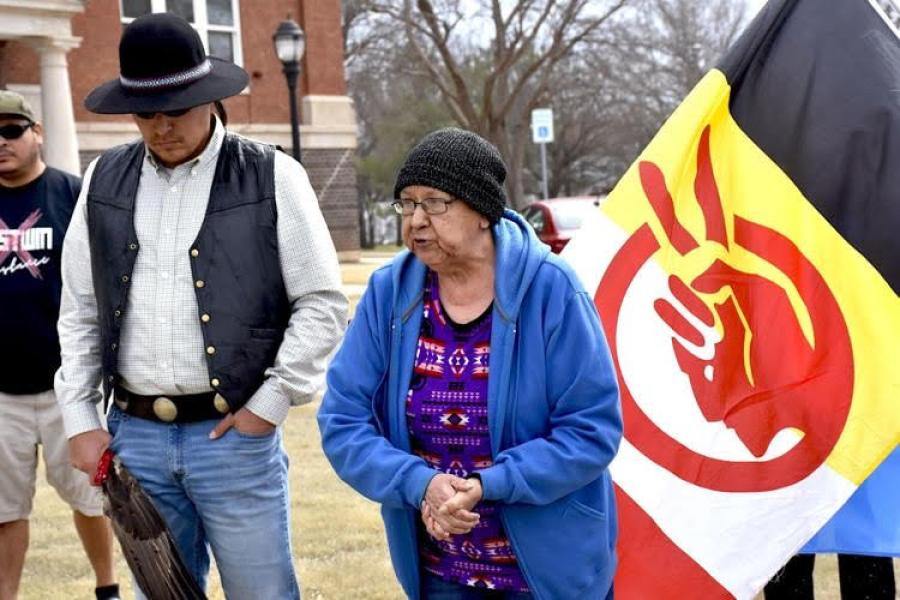The artistic and financial success of Kevin Costner's Dances with Wolves plus the 500th anniversary of Christopher Columbus' errant voyage to the Western Hemisphere have caused the mainstream media to put American Indians on their agenda in a big way for the first time since the illegal occupation of Wounded Knee, South Dakota in 1973.
All this attention is not necessarily good. When articles written by miniformed journalists serve to perpetuate myths and misconceptions, what purpose do they serve? Most Americans, journalists included, are already ignorant about Native America. Their ignorance is only compounded by half-backed news articles that dwell primary on the negative.
There are major differences between Indian's view of themselves and the distorted images in the media. Consider this simple fact: "not all of your heroes are our heroes."
George Armstrong Custer is not our hero - obviously. That President Andrew Jackson is not hero is not so obvious. Andrew jackson was president of the United States when the Indian Removal Act of 1830 became law. It called for the forced removal of all the tries in the eastern seaboard states to the Oklahoma Territory. It led to what the Indians have called "The Trial of Tears," a march that left thousands of Indians dead along the way, the American version of the Bataan Death March in the Philippine Islands in World War II.
The next thing to consider is that many events that show the United States government in a bad light, such as the "Trail of Tears," do not appear in the books used to teach the young of this nation about American history.
There are two major reasons that most non-Indian journalists have such a hard time reporting on Indians and Indian tribes. They are unable to consider Indian nations as sovereign, emerging Third World nations within the United States of America, and they are ignorant about treaties.
Indian nations were sovereign entities long before the advent of the White man. As a matter of record,many of the Indian nations were never military defeated. They were forced to surrender because of the deliberate destruction of their economic base. A good example is the destruction of the buffalo herds, which crippled many of the tribes of the Great Plains and eventually forced them to succumb. One must understand that the buffalo was a walking symbol of life to the Plains Indian. It was a spiritual symbol, but equally important to the Plains tribes, this one beast clothed, fed, and housed them. For how many more years would the tribes of the Great Sioux Nation have fought the United State soldiers if the buffalo had not been destroyed.
If the diseases brought to this hemisphere by the white man had not claimed the lives of millions of Indians who had no immunity, would America's history be different?
These basic examples show what happens when two different cultures collide. The values held by each culture are different. Indians believed in tribal ownership of land, not individual ownership. Goods were often traded between tribes to secure passage across - even the temporary use of - certain lands. Some territories were taken by tribal warfare. The lands were never sold.
The story about Manhattan being sold for $24 in trinkets is a classic example of historical misunderstanding. Most Indian historians believe that, since Indian nations never considered selling land, the tribes involved in the exchange of trinkets for Manhattan really believed that they were only letting the foreigners use the land. The White man never understood this concept and considered the taking of the land a "done deed."
This brief overview is not intended to be a lesson in history as seen through the eyes of the Indian people. It is intended to point out that, owing to cultural differences, extremely differing points of view must be taken into consideration when reporting from Indian country.
Consider that the federal and state government have created a mishmash of laws affecting Indian people and nations. Some laws differ dramatically from state to state. For example, in some states Indian tribes are affected by Public Law 280, which gives these states law enforcement jurisdiction. But there are other states where Public Law 280 doesn't apply. These states do not have law enforcement or judicial jurisdiction on reservation lands.
In some states like Okalahoma, where more than 100,000 American Indians live, there are no reservations. Then there are states like South Dakots, where Indian lands have clearly defined boundaries and borders, over which the state has absolutely no jurisdiction.
Recently I tried to explain to a black journalist from Nigeria that the Pine Ridge Reservation of South Dakota, the place of my birth, has its own judiciary, and its own governing body. Since he was never taught such a concept in his study of America, he found it very hard to comprehend.
He did, however, confirm what I have learned from many of the foreign journalists attending school in America, particularly been colonized. He looked at the United States as a land with two faces, a land preaching freedom and justice to the world but unable to fulfill those promises to its own indigenous peoples. He looked upon the American Indians as victims to colonization.
One of the most elementary and basic rules of journalism is often totally ignored in reporting on Indians and Indian country. The rule as taught in every J-school in the country goes, "If your mother says she loves you, check it out."
If someone tells you he or she is Indian and a spokesperson for an organization or a tribe, check it out. Ask them for proof of enrollment in an Indian tribe. Ask them for proof of involvement in an Indian tribe. It is a simple matter to check their status by calling the enrollment office of the tribe in which they claim membership. When one news chain claimed a large number of Indian employees. I called each one was a legally enrolled member of an Indian tribe. If a person applies for a job claiming to be Indian, don't take their word for it. As you would with any claim by a job applicant, check it out.
The other elementary rule of journalism that is often lost when people reports on Indians is - be objective. Always remember that there are two sides to every story.
In the past two years major newspapers and television networks have made a practice of seeking out prestigious journalism awards literally over the body of the American Indians. A New Mexico newspaper won a Scripps-Howard award for a bloated series on alcoholism among the Navajos, with particular focus on Gallup, New Mexico, a notorious border town. An Alaskan newspaper won a Pulitzer for its windy series on alcoholism among the tribes of Alaska. NBC television won an Emmy for its terribly onesided series entitled "A Tragedy at Pine Ridge," a not-so-original report on alcoholism on the Pine Ridge Reservation of South Dakota.
What this proves to me is that readers, and supposed intellectuals who present awards, love to read about or see the misery of other races of people, particularly First Americans. Never mind that the other side of the story was never told.
Of course a series of articles on a wonderful man named Gene Thin Elk, who started the Red Road to Recovery movement that is sweeping Indian country, and who is ripping down the walls of alcoholism by addressing the causes through the spiritual eyes of the afflicted, is not news.
When a large tribe like the Cheyenme River Sioux Tribe of South dakota, a tribe living on a reservation of more than who million acres, passes a resolution to end alcoholism by the year 2000, and passes a law to regulate the sale of all alcoholic beverages within its boundaries, and when it begins to enforce that law by shutting down liquor stores and bars which refuse to purchase tribal liquor and business licenses, it is not national news. Why?
If every journalist would read the following comment, by a letter writer to the Wall Street Journal, and apply it to Indian country, we would be on our way to achieving objective reporting. The writer said: "I have always thought that all Americans were free to find their own limitations. It is the freedom to fail that allows the hope of success and without hope anyone is disabled." Until a few years ago, the Indian people were not allowed the freedom to fail. Most of their failures have come at the hands of a paternalistic government.
The fact that the Indian people themselves are addressing their long-standing problems,and are on the way to solving many of them because, for the first time, they are they are being allowed to do it themselves, is not news.
Print and electronic journalists have played upon the ignorance of their readers when it comes to reporting on Indians, even though, I suspect, they know better. They realize that we are a very small minority and that the repercussions of their inaccurate stories will therefore be miniscule. They belief that they can turn in any article about Indians, no matter how inaccurate, with total impunity. In most cases they are right, because their editors are also ill-equipped to edit their stories.
Nationwide, the media's standard approach is to check the calendar occasionally and then set aside a little time and a reporter or two for a once-in-a-decade, epic Indian series. More likely than not, the epic is a labor to read, and usually it is a rehash of all that is bad in Indian country.
Who is the winner with this type of journalism? The reporting organizations? Sometimes they do win large awards. The readers? Not if they are being fed stereo-types; their ignorance is only being extended. Certainly the people of the Indian nations are not the winners - they are probably the biggest losers.
My advice to eager reporters assigned to Indian country is basic and simple: do your homework. Look at these articles as challenges. If you must go to an Indian journalist for leads don't be so falsely proud that you ignore a knowledgeable source.
And for God's sake, don't find yourself a pet spokesperson. What Indian can speak for hundreds of different nations? That's like finding a European spokesman to talk for all the nations of Europe.
If you are writing about health, find Indian professionals in that field. The same holds true for education, tribal government, justice and on and on. Remember, if you travel to Indian country determined to find the worst, that is exactly what you will find. Don't report on the obvious - broken down cars, winos sitting in alleys - and don't be afraid to use the local tribal government as a source. After all, it is the elected governing body of the tribe.
Never forget that each Indian tribe has its own official spokesperson. Don't bypass that official just because you think he or she might be feeding you tribal propaganda. Reporters attending news conferences for state governors and presidents of the United States are able to cut through the baloney, for the most part. Tribal spokespeople are the same. They are employed by the tribe to give out political information. Take what they say with a grain of salt, but don't ignore them. They can often give you invaluable leads.
In many Indian tribes the children are taught that direct and prolonged eye contact is considered very disrepectful. If the person you interview does not make continuous eye contact, that person should not be considered shy or possibly dishonest. It is a matter or cultural differences, nothing more.
This article may not be the media educator I would like it to be because after 20 years of being a media watchdog for the Indian people, I have become a skeptic. But it is a small beginning - and as the old Indian saying goes, "When one sets out on a trip of 100 miles, it always begins with a single step."
In the long run, it is management that will decide whether the non-Indian press continue to report the bureaucratic party line to the detriment of the Indian nations or chooses to put a little elbow grease into the stories that it writes. Hopefully this article will reach into the rarefield air of the editors and network moguls of the national media and cause them to assign reporters to Indian country who have the background and training to be knowledgeable and objective.
Educating America abut the true history and contemporary face of Indian country will be a monumental task, and it must beginning with the media. So far the media has failed this task quite miserably. Keep in mind that Indian America has not been sealed up in a vacuum for the past 200 years. In order to survive, it has progressed, in keeping with its traditions and culture.
Begin with these facts. We are not "your Indians," the vanishing Americans, people still living in teepees. We do not all live on welfare, we do pay taxes, we are not all alcoholics. We do not get a government check every month. We are people who believe in our own sovereignty. We believe we can progress with the rest of America without losing our spirituality, culture, or traditions. Knowing these things you will be able to approach a news story with more objectively and a clearer understanding of Native America.
Article copyright Cultural Survival, Inc.



